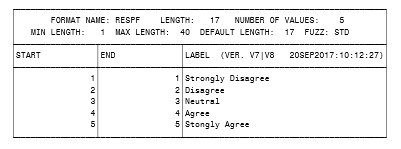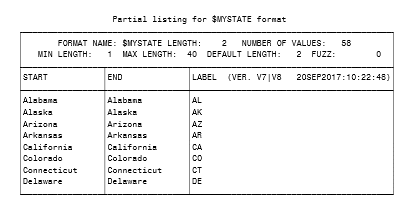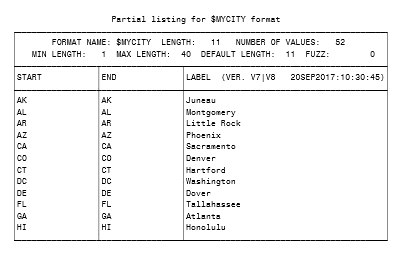 During my 35 years of using SAS® software, I have found the CNTLIN and CNTLOUT options in the FORMAT procedure to be among the most useful features that I routinely suggest to other SAS users. The CNTLIN option enables you to create user-defined formats from a SAS data set (input control data set). The CNTLOUT option enables you to create a SAS data set (output control data set) containing format details from an entry in a SAS format catalog.
During my 35 years of using SAS® software, I have found the CNTLIN and CNTLOUT options in the FORMAT procedure to be among the most useful features that I routinely suggest to other SAS users. The CNTLIN option enables you to create user-defined formats from a SAS data set (input control data set). The CNTLOUT option enables you to create a SAS data set (output control data set) containing format details from an entry in a SAS format catalog.
In this blog post, I provide a few examples demonstrating how to use the CNTLIN option. I also mention how to use the CNTLOUT option to store your format information in case you need to move to a new operating environment.
You can store all the format details from a SAS format catalog in a CNTLOUT data set and later restore them in a format catalog in your new operating environment using the CNTLIN option. For details, see SAS Usage Note 22194: “How to use the CNTLOUT= and CNTLIN= options in PROC FORMAT to move formats from one platform to another.”
A data set for the CNTLIN option contains variables that give specific information about ranges and values. At a minimum, the data set must contain the following variables:
FMTNAME specifies a character variable whose value is the format or informat name.
START specifies a variable that gives the range's starting value.
LABEL specifies a variable whose value is associated with a format or an informat.
For details about input and output control data sets, see the “FORMAT Procedure” section of Base SAS® 9.4 Procedures Guide, Seventh Edition.
Create a Numeric Format
The following simple example using the CNTLIN option creates a numeric format named respf:
data test; input response desc $20.; datalines; 1 Strongly Disagree 2 Disagree 3 Neutral 4 Agree 5 Stongly Agree ; run; data crfmt; set test; start=response; label=desc; fmtname='respf'; run; proc format library=work cntlin=crfmt fmtlib; select respf; run; |

Reveal Data Set Variables
To see the other variables that are included in data sets created by the CNTLIN and CNTLOUT options, use CNTLOUT to create a data set for the respf format created above:
proc format library=work cntlout=outfmt; select respf; run; proc print data=outfmt; run; |
Add Additional Ranges
To add another range to the respf format, you can use DATA step processing with the data set created by the CNTLOUT option. Then, re-create the format using the CNTLIN option:
data infmt; set outfmt end=last; output; if last then do; HLO='O'; /* indicates a special other range */ label='NA'; output; end; run; proc format library=work cntlin=infmt fmtlib; select respf; run; |

Convert a State Name to Its Postal Abbreviation
One use for the CNTLIN option is to create a format that converts a state name to its 2-letter postal abbreviation. For example, this option can convert 'North Carolina' to 'NC'. Because SAS does not have a function or format to convert state names to postal abbreviations, this is an excellent use of the CNTLIN option.
We can use data from the SASHELP.ZIPCODE data set to create a user-defined format using the CNTLIN option, as shown below:
proc sql noprint; create table crfmt as select distinct statename as start, statecode as label, '$mystate' as fmtname from sashelp.zipcode; quit; proc format library=work cntlin=crfmt fmtlib; select $mystate; run; |

Identify State Capitals
In a similar manner, we can use the MAPS.USCITY data set to create a user-defined format that identifies state capitals from the 2-letter state abbreviation. See the sample code and partial results below:
proc sql noprint; create table crfmt as select distinct statecode as start, city as label, '$mycity' as fmtname from maps.uscity where capital='Y'; quit; proc format library=work cntlin=crfmt fmtlib; select $mycity; run; |

Use External Data Sources
You can gather information from external data sources and read that information into a data set created by the CNTLIN option to create user-defined formats.
The following example uses ICD10 medical diagnosis codes. I downloaded a list of ICD10 codes and their descriptions into a Microsoft Excel file from the Center for Medicare & Medicaid Services website. Then, I created a user-defined format from the first 25 records:
Note: You can also download the codes as a text file.
/* This code reads in the Excel file. */ proc import out==myicd10 datafile= "C:\Section111ValidICD10-2017.xlsx" dbms=excelcs replace; range="'Valid ICD10 2017 & NF Exclude$'"; scantext=yes; usedate=yes; scantime=yes; run; data crfmt; set myicd10 (obs=25); fmtname='$myicd'; start=code; label=short_description; run; title1 'ICD10 Format'; title3 'FMTLIB results only display the first 40 characters of the label'; proc format library=work cntlin=crfmt fmtlib; select $myicd; run; |

A more complicated example that uses other data set variables created by the CNTLIN option is included in the linked sample program in Sample 47312: “Create a user-defined format containing decile ranges from PROC UNIVARIATE results.”
If you can think of a scenario in which the CNTLIN format would be helpful, give it a try. If you have questions, you can ask via SAS Communities or contact us in SAS Technical Support.

1 Comment
What is the efficiency of very long format lists? I would use SQL joins for all of the examples you give here. They have the advantage of a clean well-known syntax and indexes. A view would (should) save the intermediate table.
.
In case anyone at SAS would like to use a non-USA example for all us customers out here in the sticks, you could try the départements in France. There are others. 🙂